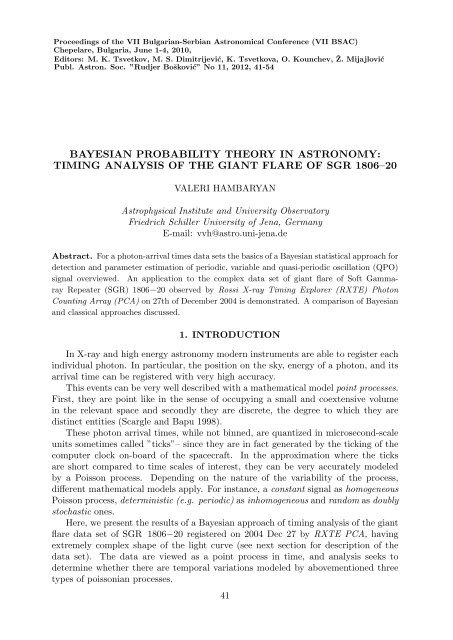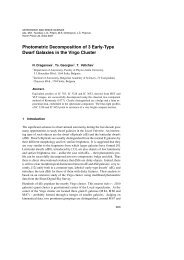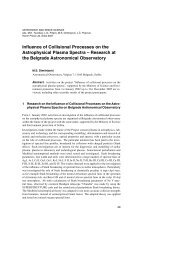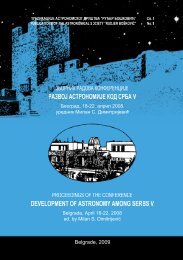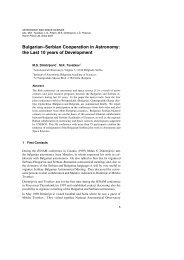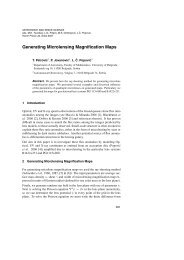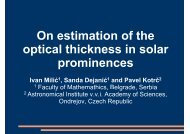bayesian probability theory in astronomy: timing analysis of the giant ...
bayesian probability theory in astronomy: timing analysis of the giant ...
bayesian probability theory in astronomy: timing analysis of the giant ...
Create successful ePaper yourself
Turn your PDF publications into a flip-book with our unique Google optimized e-Paper software.
Proceed<strong>in</strong>gs <strong>of</strong> <strong>the</strong> VII Bulgarian-Serbian Astronomical Conference (VII BSAC)<br />
Chepelare, Bulgaria, June 1-4, 2010,<br />
Editors: M. K. Tsvetkov, M. S. Dimitrijević, K. Tsvetkova, O. Kounchev, Ž. Mijajlović<br />
Publ. Astron. Soc. ”Rudjer Bošković” No 11, 2012, 41-54<br />
BAYESIAN PROBABILITY THEORY IN ASTRONOMY:<br />
TIMING ANALYSIS OF THE GIANT FLARE OF SGR 1806–20<br />
VALERI HAMBARYAN<br />
Astrophysical Institute and University Observatory<br />
Friedrich Schiller University <strong>of</strong> Jena, Germany<br />
E-mail: vvh@astro.uni-jena.de<br />
Abstract. For a photon-arrival times data sets <strong>the</strong> basics <strong>of</strong> a Bayesian statistical approach for<br />
detection and parameter estimation <strong>of</strong> periodic, variable and quasi-periodic oscillation (QPO)<br />
signal overviewed. An application to <strong>the</strong> complex data set <strong>of</strong> <strong>giant</strong> flare <strong>of</strong> S<strong>of</strong>t Gammaray<br />
Repeater (SGR) 1806−20 observed by Rossi X-ray Tim<strong>in</strong>g Explorer (RXTE) Photon<br />
Count<strong>in</strong>g Array (PCA) on 27th <strong>of</strong> December 2004 is demonstrated. A comparison <strong>of</strong> Bayesian<br />
and classical approaches discussed.<br />
1. INTRODUCTION<br />
In X-ray and high energy <strong>astronomy</strong> modern <strong>in</strong>struments are able to register each<br />
<strong>in</strong>dividual photon. In particular, <strong>the</strong> position on <strong>the</strong> sky, energy <strong>of</strong> a photon, and its<br />
arrival time can be registered with very high accuracy.<br />
This events can be very well described with a ma<strong>the</strong>matical model po<strong>in</strong>t processes.<br />
First, <strong>the</strong>y are po<strong>in</strong>t like <strong>in</strong> <strong>the</strong> sense <strong>of</strong> occupy<strong>in</strong>g a small and coextensive volume<br />
<strong>in</strong> <strong>the</strong> relevant space and secondly <strong>the</strong>y are discrete, <strong>the</strong> degree to which <strong>the</strong>y are<br />
dist<strong>in</strong>ct entities (Scargle and Bapu 1998).<br />
These photon arrival times, while not b<strong>in</strong>ned, are quantized <strong>in</strong> microsecond-scale<br />
units sometimes called ”ticks”– s<strong>in</strong>ce <strong>the</strong>y are <strong>in</strong> fact generated by <strong>the</strong> tick<strong>in</strong>g <strong>of</strong> <strong>the</strong><br />
computer clock on-board <strong>of</strong> <strong>the</strong> spacecraft. In <strong>the</strong> approximation where <strong>the</strong> ticks<br />
are short compared to time scales <strong>of</strong> <strong>in</strong>terest, <strong>the</strong>y can be very accurately modeled<br />
by a Poisson process. Depend<strong>in</strong>g on <strong>the</strong> nature <strong>of</strong> <strong>the</strong> variability <strong>of</strong> <strong>the</strong> process,<br />
different ma<strong>the</strong>matical models apply. For <strong>in</strong>stance, a constant signal as homogeneous<br />
Poisson process, determ<strong>in</strong>istic (e.g. periodic) as <strong>in</strong>homogeneous and random as doubly<br />
stochastic ones.<br />
Here, we present <strong>the</strong> results <strong>of</strong> a Bayesian approach <strong>of</strong> tim<strong>in</strong>g <strong>analysis</strong> <strong>of</strong> <strong>the</strong> <strong>giant</strong><br />
flare data set <strong>of</strong> SGR 1806−20 registered on 2004 Dec 27 by RXTE PCA, hav<strong>in</strong>g<br />
extremely complex shape <strong>of</strong> <strong>the</strong> light curve (see next section for description <strong>of</strong> <strong>the</strong><br />
data set). The data are viewed as a po<strong>in</strong>t process <strong>in</strong> time, and <strong>analysis</strong> seeks to<br />
determ<strong>in</strong>e whe<strong>the</strong>r <strong>the</strong>re are temporal variations modeled by abovementioned three<br />
types <strong>of</strong> poissonian processes.<br />
41
VALERI HAMBARYAN<br />
2. SGR 1806–20 SUPER FLARE ON 27 Dec 2004<br />
2.1. What are SGRs? State <strong>of</strong> <strong>the</strong> art<br />
Over <strong>the</strong> last few years, a number <strong>of</strong> observational discoveries have aga<strong>in</strong> brought<br />
Magnetars (ultra-magnetized isolated neutron stars) to <strong>the</strong> forefront <strong>of</strong> researchers<br />
attention. These extreme objects comprise <strong>the</strong> Anomalous X-ray Pulsars (AXPs;<br />
10 objects) and <strong>the</strong> S<strong>of</strong>t Gamma-ray Repeaters (SGRs; 5 objects), which are observationally<br />
very similar classes <strong>in</strong> many respects (for a recent review see Mereghetti<br />
2008). They are all slow X-ray pulsars with sp<strong>in</strong> periods clustered <strong>in</strong> a narrow range<br />
(P ∼ 2–12 s), relatively large period derivatives ( P ˙ ∼ 10 −13 − 10 −10 s s −1 ), sp<strong>in</strong>-down<br />
ages <strong>of</strong> 10 3 −10 4 yr, and magnetic fields, as <strong>in</strong>ferred from <strong>the</strong> classical magnetic dipole<br />
sp<strong>in</strong>-down formula, <strong>of</strong> 10 14 − 10 15 G.<br />
SGRs undergo periods <strong>of</strong> activity dur<strong>in</strong>g which recurrent bursts with sub-second<br />
duration and peak lum<strong>in</strong>osities <strong>of</strong> ∼ 10 38 − 10 41 erg/s are emitted. SGRs also show,<br />
on rare occasions, much more extreme events known as <strong>giant</strong> flares. These are characterized<br />
by an <strong>in</strong>itial spike <strong>of</strong> duration comparable to that <strong>of</strong> recurrent bursts, but<br />
many orders <strong>of</strong> magnitude larger lum<strong>in</strong>osity. Only three <strong>giant</strong> flares have so far been<br />
observed <strong>in</strong> over 30 yr <strong>of</strong> monitor<strong>in</strong>g.<br />
Accord<strong>in</strong>g to <strong>the</strong> magnetar model (Thompson and Duncan 1993, Thompson and<br />
Murray 2001) energy is fed impulsively to <strong>the</strong> neutron star magnetosphere when local<br />
”crustquakes” let magnetic helicity propagate outwards, giv<strong>in</strong>g rise to recurrent bursts<br />
with a large range <strong>of</strong> amplitudes. Giant flares are believed to orig<strong>in</strong>ate from large-scale<br />
rearrangements <strong>of</strong> <strong>the</strong> <strong>in</strong>ner field or catastrophic <strong>in</strong>stabilities <strong>in</strong> <strong>the</strong> magnetosphere<br />
(Thompson and Duncan 2001, Lyutikov 2003). Most <strong>of</strong> this energy breaks out <strong>of</strong> <strong>the</strong><br />
magnetosphere <strong>in</strong> a fireball <strong>of</strong> plasma expand<strong>in</strong>g at relativistic speeds which results<br />
<strong>in</strong> <strong>the</strong> <strong>in</strong>itial spike <strong>of</strong> <strong>giant</strong> flares. The decay<strong>in</strong>g, oscillat<strong>in</strong>g tail that follows <strong>the</strong> spike<br />
displays many tens <strong>of</strong> cycles at <strong>the</strong> neutron star sp<strong>in</strong> rate. This is <strong>in</strong>terpreted as<br />
be<strong>in</strong>g due to a ”trapped fireball” which rema<strong>in</strong>s anchored <strong>in</strong>side <strong>the</strong> magnetosphere<br />
and cools <strong>in</strong> a few m<strong>in</strong>utes. The total energy released <strong>in</strong> this tail is ∼ 10 44 erg <strong>in</strong> all<br />
three events detected so far.<br />
Until 2004, <strong>the</strong> energy budget <strong>of</strong> SGRs and AXPs was believed to be dom<strong>in</strong>ated by<br />
<strong>the</strong>ir persistent emission at a level <strong>of</strong> ∼ 10 35 erg s −1 . This translated <strong>in</strong>to an <strong>in</strong>ternal<br />
field <strong>of</strong> ∼ 10 15 G. The properties <strong>of</strong> <strong>the</strong> 2004 Dec 27 <strong>giant</strong> flare from SGR1806-20<br />
imply that <strong>the</strong> emission budget <strong>of</strong> Magnetars is dom<strong>in</strong>ated by <strong>giant</strong> flares, see e.g.<br />
Stella et al. (2009). This <strong>the</strong>refore has important implications for several subjects at<br />
<strong>the</strong> forefront <strong>of</strong> research.<br />
A power spectrum <strong>analysis</strong> <strong>of</strong> <strong>the</strong> high time resolution data from <strong>the</strong> 2004 Dec 27<br />
event <strong>of</strong> SGR1806-20, observed with <strong>the</strong> X-Ray Tim<strong>in</strong>g Explorer (RXTE), led to <strong>the</strong><br />
discovery <strong>of</strong> fast Quasi Periodic Oscillations (QPOs) <strong>in</strong> <strong>the</strong> X-ray flux <strong>of</strong> <strong>the</strong> decay<strong>in</strong>g<br />
tail <strong>of</strong> SGR (Israel et al. 2005). QPOs <strong>of</strong> different frequencies were detected, some<br />
<strong>of</strong> which were active simultaneously and displayed highly significant QPO signals at<br />
about 18, 26, 30, 93, 150, 625 and 1840 Hz (Watts and Strohmayer 2006). A re<strong>analysis</strong><br />
<strong>of</strong> <strong>the</strong> decay<strong>in</strong>g tail data from <strong>the</strong> 1998 <strong>giant</strong> flare <strong>of</strong> ano<strong>the</strong>r Magnetar, SGR<br />
1900+14, revealed QPOs around frequencies <strong>of</strong> 28, 54, 84 and 155 Hz (Strohmayer<br />
and Watts 2006). H<strong>in</strong>ts for a signal at ∼ 43 Hz <strong>in</strong> <strong>the</strong> March 1979 event from SGR<br />
42
BAYESIAN PROBABILITY THEORY IN ASTRONOMY: TIMING ANALYSIS OF THE GIANT FLARE...<br />
0526-66 were reported as early as 1983 (Barat et al. 1983). All QPO signals show large<br />
amplitude variations with time and especially with <strong>the</strong> phase <strong>of</strong> <strong>the</strong> stars rotational<br />
modulation.<br />
2.2. Observational data<br />
The <strong>giant</strong> flare <strong>of</strong> SGR 1806−20 has been observed by many space based missions.<br />
The data recorded by RXTE PCA <strong>in</strong>strument, consist<strong>in</strong>g <strong>of</strong> five Xenon-filled detectors<br />
cover<strong>in</strong>g <strong>the</strong> energy range 2−50 keV, used <strong>the</strong> configuration GoodXenon, which<br />
records all good events detected <strong>in</strong> <strong>the</strong> Xenon chamber with full tim<strong>in</strong>g accuracy <strong>of</strong> 1<br />
µs. Publicly available data were retrieved by <strong>the</strong> XTE Data F<strong>in</strong>der (XDF) user <strong>in</strong>terface<br />
(Rots and Hilldrup 1997). Event data files have been created and photon arrival<br />
times were corrected for <strong>the</strong> solar barycenter us<strong>in</strong>g scripts provided <strong>in</strong> <strong>the</strong> package<br />
XTE ftools. The data set consists <strong>of</strong> 698770 registered photons. However, dur<strong>in</strong>g <strong>the</strong><br />
<strong>in</strong>itial <strong>in</strong>tensive spike phase <strong>of</strong> <strong>the</strong> <strong>giant</strong> flare <strong>the</strong> detectors were saturated. For that<br />
reason, <strong>in</strong> our <strong>analysis</strong> we use <strong>the</strong> data after ∼ 8.9sec <strong>of</strong> <strong>the</strong> flare onset, consist<strong>in</strong>g <strong>of</strong><br />
∼ 650000 photon arrival times, clearly cover<strong>in</strong>g 51 rotational cycles <strong>of</strong> SGR 1806−20<br />
(see Fig. 1).<br />
Figure 1. Light curve <strong>of</strong> <strong>the</strong> RXTE <strong>giant</strong> flare <strong>of</strong> SGR 1806−20 observed on 27th<br />
<strong>of</strong> December 2004. The general decay <strong>of</strong> <strong>the</strong> <strong>giant</strong> flare with a bumpy structure on<br />
top <strong>of</strong> it, namely a strongly periodic signal due to rotation (7.56 sec). The <strong>in</strong>set<br />
panel shows <strong>the</strong> rotational modulated light curve (filled circles) toge<strong>the</strong>r with fitted<br />
piecewise constant model (solid l<strong>in</strong>e) (Hutter 2007), shown here only for 2.5 rotational<br />
cycles, with a very complex light curve structure. See text for details.<br />
It is clear that observational detection and parameter estimation <strong>of</strong> QPO frequencies<br />
may play a crucial role for test<strong>in</strong>g any <strong><strong>the</strong>ory</strong> predict<strong>in</strong>g eigenfrequencies <strong>of</strong> <strong>the</strong><br />
neutron star. In this connection, tim<strong>in</strong>g <strong>analysis</strong> <strong>of</strong> complex flare data set <strong>of</strong> SGR<br />
1806−20, with <strong>the</strong> aim <strong>of</strong> QPO detection, may be divided <strong>in</strong>to several mutually con-<br />
43
VALERI HAMBARYAN<br />
nected, challeng<strong>in</strong>g problems. They <strong>in</strong>clude <strong>the</strong> significance <strong>of</strong> quasi-periodic signal<br />
detection and parameter estimation with high precision. Indeed, <strong>the</strong> decay<strong>in</strong>g tail,<br />
<strong>of</strong> <strong>the</strong> <strong>giant</strong> flare <strong>of</strong> SGR 1806−20, itself has a bumpy structure, very complex light<br />
curve shape modulated by rotation <strong>of</strong> <strong>the</strong> neutron star (see Fig. 1).<br />
Thus, for <strong>in</strong>vestigation <strong>of</strong> this dataset a procedure properly should take <strong>in</strong>to account<br />
all <strong>the</strong>se variations.<br />
2.3. Tim<strong>in</strong>g <strong>analysis</strong> with a Bayesian change po<strong>in</strong>t detection method<br />
In order to study <strong>the</strong> changes <strong>of</strong> <strong>the</strong> photon arrival times (variability detection) we<br />
performed a tim<strong>in</strong>g <strong>analysis</strong> <strong>of</strong> <strong>the</strong> datasets us<strong>in</strong>g a Bayesian change po<strong>in</strong>t detection<br />
method 1 developed by Scargle (1998, 2000). This method is well suited for a statistical<br />
exam<strong>in</strong>ation when <strong>the</strong> arrival times <strong>of</strong> <strong>in</strong>dividual X-ray photons are registered (see<br />
Hambaryan et al. 1999, Schwope et al. 2002). It is superior to methods which work<br />
on b<strong>in</strong>ned data, s<strong>in</strong>ce it requires no a priori knowledge <strong>of</strong> <strong>the</strong> relevant time-scale <strong>of</strong><br />
<strong>the</strong> variability structure which will be <strong>in</strong>vestigated.<br />
Scargle’s (1998, 2000) method decomposes a given set <strong>of</strong> photon count<strong>in</strong>g data <strong>in</strong>to<br />
Bayesian blocks with piecewise constant count-rate accord<strong>in</strong>g to Poisson statistics.<br />
Bayesian blocks are built by a Cell Coalescence algorithm (Scargle 2000), which beg<strong>in</strong>s<br />
with a f<strong>in</strong>e-gra<strong>in</strong>ed segmentation. It uses a Voronoi tessellation 2 <strong>of</strong> data po<strong>in</strong>ts, where<br />
neighbor<strong>in</strong>g cells are merged if allowed by <strong>the</strong> correspond<strong>in</strong>g marg<strong>in</strong>al likelihoods<br />
(Scargle 2000).<br />
We repeat here <strong>the</strong> essential parts <strong>of</strong> <strong>the</strong> method, expand<strong>in</strong>g upon particular modifications<br />
<strong>of</strong> <strong>the</strong> orig<strong>in</strong>al method as used <strong>in</strong> <strong>the</strong> present application. Assume that dur<strong>in</strong>g<br />
a cont<strong>in</strong>uous observational <strong>in</strong>terval <strong>of</strong> length T , consist<strong>in</strong>g <strong>of</strong> m discrete moments <strong>in</strong><br />
time (spacecraft’s ”clock tick”), a set <strong>of</strong> photon arrival times D (t i , t i+1 , ..., t i+n ) is<br />
registered. Suppose now that we want to use <strong>the</strong>se data to compare two compet<strong>in</strong>g<br />
hypo<strong>the</strong>ses, The first hypo<strong>the</strong>sis is that <strong>the</strong> data are generated from a constant rate<br />
Poisson process (model M 1 ) and <strong>the</strong> second one from two-rate Poisson process (model<br />
M 2 ). Evidently, model M 1 is described by only one parameter θ (<strong>the</strong> count rate) <strong>of</strong><br />
<strong>the</strong> one rate Poisson process while <strong>the</strong> model M 2 is described by parameters θ 1 , θ 2<br />
and τ. The parameter τ is <strong>the</strong> time when <strong>the</strong> Poisson process switches from θ 1 to θ 2<br />
dur<strong>in</strong>g <strong>the</strong> total time T <strong>of</strong> observation, which thus is divided <strong>in</strong> <strong>in</strong>tervals T 1 and T 2 .<br />
By tak<strong>in</strong>g as a background <strong>in</strong>formation (I) <strong>the</strong> proposition that one <strong>of</strong> <strong>the</strong> models<br />
under consideration is true and by us<strong>in</strong>g Bayes’ <strong>the</strong>orem we can calculate <strong>the</strong> posterior<br />
<strong>probability</strong> <strong>of</strong> each model by (<strong>the</strong> <strong>probability</strong> that M k (k = 1, 2) is <strong>the</strong> correct model,<br />
see, e.g., Jaynes and Bretthorst 2003)<br />
P r(M k |D, I) = P r(D|M k, I)<br />
P r(M k |I) (1)<br />
P r(D|I)<br />
where P r(D|M k , I) is <strong>the</strong> (marg<strong>in</strong>al) <strong>probability</strong> <strong>of</strong> <strong>the</strong> data assum<strong>in</strong>g model M k ,<br />
and P r(M k |I) is <strong>the</strong> prior <strong>probability</strong> <strong>of</strong> model M k (k = 1, 2). The term <strong>in</strong> <strong>the</strong><br />
1 In general terms, <strong>the</strong> change-po<strong>in</strong>t methodology deals with sets <strong>of</strong> sequentially ordered observations<br />
(as <strong>in</strong> time) and determ<strong>in</strong>es whe<strong>the</strong>r <strong>the</strong> fundamental mechanism generat<strong>in</strong>g <strong>the</strong> observations<br />
has changed dur<strong>in</strong>g <strong>the</strong> time <strong>the</strong> data have been ga<strong>the</strong>red (see, e.g. Csorgö and Horváth 1997).<br />
2 The Voronoi cell for a data po<strong>in</strong>t consists <strong>of</strong> all <strong>the</strong> space closer to that po<strong>in</strong>t than to any o<strong>the</strong>r<br />
data po<strong>in</strong>t.<br />
44
BAYESIAN PROBABILITY THEORY IN ASTRONOMY: TIMING ANALYSIS OF THE GIANT FLARE...<br />
denom<strong>in</strong>ator is a normalization constant, and we may elim<strong>in</strong>ate it by calculat<strong>in</strong>g <strong>the</strong><br />
ratio <strong>of</strong> <strong>the</strong> posterior probabilities <strong>in</strong>stead <strong>of</strong> <strong>the</strong> probabilities directly. Indeed, <strong>the</strong><br />
extent to which <strong>the</strong> data support model M 2 over M 1 is measured by <strong>the</strong> ratio <strong>of</strong> <strong>the</strong>ir<br />
posterior probabilities and is called <strong>the</strong> posterior odds ratio<br />
O 21 ≡ P r(M [<br />
2|D, I) P<br />
P r(M 1 |D, I) = r(D|M2 , I)<br />
P r(D|M 1 , I)<br />
] [ P r(M2 |I)<br />
P r(M 1 |I)<br />
]<br />
. (2)<br />
The first factor on <strong>the</strong> right-hand side <strong>of</strong> Eq. (2) is <strong>the</strong> ratio <strong>of</strong> <strong>the</strong> <strong>in</strong>tegrated or<br />
global likelihoods <strong>of</strong> <strong>the</strong> two models and is called <strong>the</strong> Bayes factor for M 2 aga<strong>in</strong>st<br />
M 1 , denoted by B 21 . The global likelihood for each model can be evaluated by<br />
<strong>in</strong>tegrat<strong>in</strong>g over nuisance parameters and <strong>the</strong> f<strong>in</strong>al result for discrete Poisson events<br />
can be represented by (see, for details, Scargle 1998, 2000, Hambaryan et al. 1999).<br />
B 21 =<br />
1 ∑<br />
B(n1 + 1, m 1 − n 1 + 1)<br />
B(n + 1, m − n + 1)<br />
×B(n 2 + 1, m 2 − n 2 + 1)∆τ ,<br />
(3)<br />
where B is <strong>the</strong> beta function, n j and m j , (j = 1, 2), respectively are <strong>the</strong> number<br />
<strong>of</strong> recorded photons and <strong>the</strong> number <strong>of</strong> ”clock ticks” <strong>in</strong> <strong>the</strong> observation <strong>in</strong>tervals <strong>of</strong><br />
lengths T 1 and T 2 . ∆τ is <strong>the</strong> time <strong>in</strong>terval between successive photons, and <strong>the</strong> sum<br />
is over <strong>the</strong> photons’ <strong>in</strong>dex.<br />
The second factor on <strong>the</strong> right-hand side <strong>of</strong> Eq. (2) is <strong>the</strong> prior odds ratio, which<br />
will <strong>of</strong>ten be equal to 1 (see below), represent<strong>in</strong>g <strong>the</strong> absence <strong>of</strong> an a priori preference<br />
for ei<strong>the</strong>r model.<br />
It follows that <strong>the</strong> Bayes factor is equal to <strong>the</strong> posterior odds when <strong>the</strong> prior odds<br />
is equal to 1. When B 21 > 1, <strong>the</strong> data favor M 2 over M 1 , and when B 21 < 1 <strong>the</strong><br />
data favor M 1 .<br />
If we have calculated <strong>the</strong> odds ratio O 21 , <strong>in</strong> favor <strong>of</strong> model M 2 over M 1 , we can<br />
f<strong>in</strong>d <strong>the</strong> <strong>probability</strong> for model M 2 by <strong>in</strong>vert<strong>in</strong>g Eq. (2), giv<strong>in</strong>g<br />
P r(M 2 |D, I) = O 21<br />
1 + O 21<br />
. (4)<br />
Apply<strong>in</strong>g this approach to <strong>the</strong> observational data set, Scargle’s (1998, 2000) method<br />
returns an array <strong>of</strong> rates, (θ 1 , θ 2 , ..., θ cp ), and a set <strong>of</strong> so called ”change po<strong>in</strong>ts”<br />
(τ 1 , τ 2 , ...., τ cp−1 ), giv<strong>in</strong>g <strong>the</strong> times when an abrupt change <strong>in</strong> <strong>the</strong> rate is determ<strong>in</strong>ed,<br />
i.e. a significant variation. This is <strong>the</strong> most probable partition<strong>in</strong>g <strong>of</strong> <strong>the</strong> observational<br />
<strong>in</strong>terval <strong>in</strong>to blocks dur<strong>in</strong>g which <strong>the</strong> photon arrival rate displayed no statistically significant<br />
variations.<br />
In Fig. 1 we visualize <strong>the</strong> outcome <strong>of</strong> <strong>the</strong> application to <strong>the</strong> observational data<br />
set, that divided it <strong>in</strong>to time <strong>in</strong>tervals (segments/blocks) with<strong>in</strong> each <strong>of</strong> <strong>the</strong>m a signal<br />
can be considered as a constnat with poissonian noise. In contrary, between those<br />
<strong>in</strong>tervals signific<strong>in</strong>at change <strong>of</strong> <strong>the</strong> observed count rate occured.<br />
Thus, next we may perform a search for a periodic/quasi-periodic signal tak<strong>in</strong>g<br />
<strong>in</strong>to account this segmentation.<br />
45
VALERI HAMBARYAN<br />
2.4. The Gregory-Loredo (Bayesian) method for periodicity search.<br />
The most widely-used procedure for detection <strong>of</strong> QPOs is an <strong>analysis</strong> <strong>of</strong> <strong>the</strong> power<br />
spectrum calculated from <strong>the</strong> fast Fourier transform (FFT) <strong>of</strong> uniformly sampled<br />
data. Application <strong>of</strong> <strong>the</strong> FFT to arrival time series data requires b<strong>in</strong>n<strong>in</strong>g <strong>of</strong> <strong>the</strong> data<br />
to produce equally spaced samples. B<strong>in</strong>n<strong>in</strong>g is a subjective procedure; <strong>the</strong> choice <strong>of</strong><br />
<strong>the</strong> b<strong>in</strong> width and edges can affect <strong>the</strong> apparent significance <strong>of</strong> a detection and limits<br />
sensitivity on short time scales. Moreover, <strong>the</strong> presence <strong>of</strong> <strong>the</strong> so-called red-noise (low<br />
frequency signal <strong>in</strong> <strong>the</strong> data, i.e. high calculated power can appear at low frequency<br />
because <strong>of</strong> long-timescale features <strong>of</strong> <strong>the</strong> data and at high frequencies from higher<br />
harmonics <strong>of</strong> complex shape strong periodic signal) may cause certa<strong>in</strong> problems with<br />
<strong>the</strong> <strong>in</strong>terpretation <strong>of</strong> <strong>the</strong> results (e.g. Bretthorst 1988). In <strong>the</strong> previous tim<strong>in</strong>g <strong>analysis</strong><br />
<strong>of</strong> <strong>the</strong> <strong>giant</strong> flare data set <strong>of</strong> SGR 1806−20 by Israel et al. (2005) and Watts and<br />
Strohmayer (2006), an averaged power spectrum was considered. Namely, for each<br />
rotational cycle or certa<strong>in</strong> rotational phase <strong>in</strong>terval <strong>of</strong> SGR 1806−20 an <strong>in</strong>dependent<br />
classical power spectrum was determ<strong>in</strong>ed depend<strong>in</strong>g on <strong>the</strong> phase <strong>of</strong> rotation and<br />
decay<strong>in</strong>g tail <strong>of</strong> <strong>the</strong> <strong>giant</strong> flare, which were co-added and averaged subsequently. This<br />
approach divides <strong>the</strong> data set <strong>in</strong>to small time <strong>in</strong>tervals, which automatically reduces<br />
<strong>the</strong> significance <strong>of</strong> any periodicity detection and nearly takes <strong>in</strong>to account <strong>the</strong> complex<br />
shape <strong>of</strong> <strong>the</strong> data set (rotational modulation and decay<strong>in</strong>g tail <strong>of</strong> flare light curves,<br />
Fig. 1). Moreover, <strong>in</strong> some circumstances it may fail to detect <strong>the</strong> periodic signal<br />
(see e.g. Gregory and Loredo 1996). Indeed, as explicitly shown by Jaynes (1987)<br />
(see also, Bretthors 1988, 2001, Gregory 2005) <strong>the</strong> <strong>probability</strong> for <strong>the</strong> frequency <strong>of</strong> a<br />
periodic s<strong>in</strong>usoidal signal is given approximately by<br />
[ ] C(fn )<br />
p(f n |D, I) ∝ exp<br />
σ 2 , (5)<br />
where C(f n ) is <strong>the</strong> squared magnitude <strong>of</strong> <strong>the</strong> FFT.<br />
To avoid subjectivity and loss <strong>of</strong> sensitivity, we used a procedure which does not<br />
require b<strong>in</strong>n<strong>in</strong>g and takes <strong>in</strong>to consideration <strong>the</strong> rotational modulation and decay<strong>in</strong>g<br />
tail <strong>of</strong> <strong>the</strong> flare (Bretthorst 1988, Gregory and Loredo 1992, 1996, Jaynes and<br />
Bretthorst 2003, Vaughan 2009).<br />
For <strong>the</strong> <strong>analysis</strong> <strong>of</strong> <strong>the</strong> data for <strong>the</strong> search <strong>of</strong> QPOs dur<strong>in</strong>g <strong>the</strong> <strong>giant</strong> flare <strong>of</strong> SGR<br />
1806−20, we applied a Bayesian method developed by Gregory and Loredo (1992)<br />
(hereafter referred to as <strong>the</strong> GL method) for <strong>the</strong> search <strong>of</strong> pulsed emission from pulsars<br />
<strong>in</strong> X-ray data, consist<strong>in</strong>g <strong>of</strong> <strong>the</strong> arrival times <strong>of</strong> events, when we have no specific prior<br />
<strong>in</strong>formation about <strong>the</strong> shape <strong>of</strong> <strong>the</strong> signal.<br />
The GL method for tim<strong>in</strong>g <strong>analysis</strong> first tests if a constant, variable or periodic<br />
signal is present <strong>in</strong> a data set. As a prticular case <strong>of</strong> a QPO 3 can be considered a<br />
periodic signal with some length <strong>of</strong> coherence, i.e. a periodic signal with additional<br />
parameters <strong>of</strong> <strong>the</strong> oscillation with start and end times. In <strong>the</strong> GL method, periodic<br />
models are represented by a signal folded <strong>in</strong>to trial frequency with a light curve shape<br />
as a stepwise function with m phase b<strong>in</strong>s per period plus a noise contribution. With<br />
3 A QPO can be <strong>the</strong> result <strong>of</strong> a random process with a cont<strong>in</strong>uous power spectrum that conta<strong>in</strong>s<br />
a broad peak, or a locally monochromatic periodic signal, <strong>the</strong> frequency <strong>of</strong> which changes over time,<br />
ei<strong>the</strong>r randomly or determ<strong>in</strong>istically, or a comb<strong>in</strong>ation <strong>of</strong> <strong>the</strong>se.<br />
46
BAYESIAN PROBABILITY THEORY IN ASTRONOMY: TIMING ANALYSIS OF THE GIANT FLARE...<br />
such a model we are able to approximate a light curve <strong>of</strong> any shape. Hypo<strong>the</strong>ses<br />
for detect<strong>in</strong>g periodic signals represents a class <strong>of</strong> stepwise periodic models with <strong>the</strong><br />
follow<strong>in</strong>g parameters: trial period, phase, noise parameter and number <strong>of</strong> b<strong>in</strong>s (m).<br />
The most probable model parameters are <strong>the</strong>n estimated by marg<strong>in</strong>alization <strong>of</strong> <strong>the</strong><br />
posterior <strong>probability</strong> over <strong>the</strong> prior specified range <strong>of</strong> each parameter. In Bayesian<br />
statistics posterior <strong>probability</strong> conta<strong>in</strong>s a term that penalizes complex models (unless<br />
<strong>the</strong>re is no significant evidence to support that hypo<strong>the</strong>sis), hence we calculate <strong>the</strong><br />
posterior <strong>probability</strong> by marg<strong>in</strong>aliz<strong>in</strong>g over a range <strong>of</strong> models, correspond<strong>in</strong>g to a<br />
prior range <strong>of</strong> number <strong>of</strong> phase b<strong>in</strong>s, m, from 2 to 12. Moreover, <strong>the</strong> GL method is<br />
well suited for variability detection, i.e. to characterize an arbitrary shape light curve<br />
with piecewise constant function Z(t) (Rots 2006).<br />
For <strong>the</strong> search and detection <strong>of</strong> QPOs we used a slightly different version <strong>of</strong> <strong>the</strong> GL<br />
method (Hambaryan et al. 2010). First we determ<strong>in</strong>ed Z(t) - apodiz<strong>in</strong>g or weight<strong>in</strong>g<br />
function (fitt<strong>in</strong>g with a piecewise constant model to characterize <strong>the</strong> complex<br />
light curve shape <strong>in</strong> <strong>the</strong> data set, <strong>giant</strong> flare decay<strong>in</strong>g tail and rotational modulated<br />
light curve, see also previous section). Then we subsequently compare compet<strong>in</strong>g<br />
hypo<strong>the</strong>sis, i.e. whe<strong>the</strong>r <strong>the</strong> data support a purely piecewise constant or piecewise<br />
constant+periodic model. If <strong>the</strong>re is an <strong>in</strong>dication <strong>of</strong> <strong>the</strong> presence <strong>of</strong> a periodic signal<br />
we determ<strong>in</strong>e also <strong>the</strong> time <strong>in</strong>tervals where it has its maximum strength (e.g. amplitude<br />
or pulsed fraction) via a Markov Cha<strong>in</strong> Monte Carlo (MCMC) approach us<strong>in</strong>g<br />
QPO start and end times as free parameters.<br />
F<strong>in</strong>ally, <strong>in</strong> <strong>the</strong> latter case, we estimate parameters (frequency, phase, amplitude,<br />
coherence length <strong>of</strong> QPO, etc.) <strong>of</strong> <strong>the</strong> periodic signal with high precision, us<strong>in</strong>g <strong>the</strong><br />
posterior probabilities <strong>of</strong> frequencies <strong>in</strong> a periodic signal:<br />
[ ∫ ωhi<br />
where C =<br />
ω lo<br />
dω<br />
ω<br />
p(ω|D, M m ) = C ω<br />
∫ 2π<br />
0<br />
1<br />
dφ<br />
W m (ω, φ) , (6)<br />
∫ ] 2π<br />
−1<br />
1<br />
dφ<br />
0 W m (ω,φ) and<br />
N!<br />
Wm (ω, φ) =<br />
n 1 !n 2 !···n m !<br />
are <strong>the</strong> normalization<br />
constant and number <strong>of</strong> ways <strong>the</strong> b<strong>in</strong>ned distribution could have arisen ”by<br />
chance”. n j (ω, φ) is <strong>the</strong> number <strong>of</strong> events fall<strong>in</strong>g <strong>in</strong>to <strong>the</strong> j th <strong>of</strong> m phase b<strong>in</strong>s given<br />
<strong>the</strong> frequency, ω, and phase, φ. N is <strong>the</strong> total number <strong>of</strong> photons (for details, see<br />
Gregory and Loredo 1992).<br />
First, we applied <strong>the</strong> GL method as implemented by Gregory and Loredo (1992)<br />
to <strong>the</strong> 2004 Dec 27 <strong>giant</strong> flare whole data set <strong>of</strong> SGR 1806−20 observed by RXTE<br />
PCA and started <strong>the</strong> tim<strong>in</strong>g <strong>analysis</strong> by perform<strong>in</strong>g a bl<strong>in</strong>d periodicity search <strong>in</strong> <strong>the</strong><br />
range <strong>of</strong> 12.0-160 Hz. Naturally, we found a very strong coherent signal at ∼ 7.56s,<br />
<strong>the</strong> pulsation period <strong>of</strong> <strong>the</strong> NS, followed by higher harmonics up to <strong>the</strong> 100Hz (see<br />
Fig. 2), which have to be excluded as potential QPO frequencies triggered by o<strong>the</strong>r<br />
phenomenon different than rotation <strong>of</strong> NS.<br />
47
VALERI HAMBARYAN<br />
Figure 2. Application <strong>of</strong> <strong>the</strong> GL method for bl<strong>in</strong>d periodicity search to <strong>the</strong> complete<br />
data set obta<strong>in</strong>ed by RXTE PCA <strong>of</strong> <strong>giant</strong> flare <strong>of</strong> SGR 1806−20 2004 Dec 27 revealed<br />
a strong coherent signal at <strong>the</strong> frequency <strong>of</strong> 0.13219244 Hz and higher harmonics up<br />
to 100Hz. Bayesian posterior <strong>probability</strong> density vs frequencies <strong>in</strong> <strong>the</strong> range <strong>of</strong> 12.0-<br />
160 Hz is shown. The <strong>in</strong>set panel shows a zoomed part <strong>of</strong> it around 16.88 Hz. Arrows<br />
are <strong>in</strong>dicat<strong>in</strong>g higher harmonics (from 125 to 132) <strong>of</strong> <strong>the</strong> fundamental frequency and<br />
<strong>the</strong> dash-dotted vertical l<strong>in</strong>e shows one <strong>of</strong> <strong>the</strong> detected QPO frequency <strong>in</strong> a short time<br />
<strong>in</strong>terval (see text, for details).<br />
Next, we divided <strong>the</strong> data set <strong>in</strong>to 51 rotational cycles (see Fig. 1). Each <strong>of</strong> <strong>the</strong>se<br />
subsamples were treated as <strong>in</strong>dependent data sets. We determ<strong>in</strong>ed <strong>the</strong> Bayesian <strong>probability</strong><br />
densities versus trial frequency. F<strong>in</strong>al probabilities were derived <strong>in</strong> two ways.<br />
First, as <strong>the</strong> likelihood <strong>of</strong> those <strong>in</strong>dependent Bayesian posterior <strong>probability</strong> density<br />
functions and <strong>the</strong> second one simply summ<strong>in</strong>g those <strong>in</strong>dependent probabilities 4 (see<br />
Fig. 3).<br />
This approach also revealed a number <strong>of</strong> rotational cycles with<strong>in</strong> which <strong>the</strong> <strong>probability</strong><br />
<strong>of</strong> <strong>the</strong> model <strong>of</strong> periodic signal is significantly higher than <strong>the</strong> constant one.<br />
Namely, dur<strong>in</strong>g time <strong>in</strong>tervals <strong>of</strong> 183.8−191.2, 244.3−251.9 and 259.4−267.1 seconds,<br />
from <strong>the</strong> flare onset, odds ratios <strong>of</strong> periodic vs constant models are ∼ 10, ∼ 30 and<br />
∼ 197, correspond<strong>in</strong>gly.<br />
4 Addition rule <strong>of</strong> probabilities: <strong>probability</strong> that <strong>the</strong> QPOs at <strong>the</strong> given frequency are present ∆t 1<br />
or ∆t 2 or both time <strong>in</strong>tervals, while likelihood (i.e. summed power spectrum) def<strong>in</strong>es <strong>the</strong> <strong>probability</strong><br />
<strong>of</strong> presence QPOs dur<strong>in</strong>g ∆t 1 and ∆t 2 (i.e. multiplication rule <strong>of</strong> probabilities, see also, Eq. 5)<br />
48
BAYESIAN PROBABILITY THEORY IN ASTRONOMY: TIMING ANALYSIS OF THE GIANT FLARE...<br />
Figure 3. The Bayesian posterior <strong>probability</strong> density vs. trial frequency <strong>of</strong> <strong>the</strong><br />
periodic signal for <strong>the</strong> <strong>giant</strong> flare data set <strong>of</strong> SGR 1806−20. QPO frequencies already<br />
detected by averaged power spectrum <strong>analysis</strong> and also with o<strong>the</strong>r mission RHESSI<br />
(Israel et al. 2005, Watts and Strohmayer 2006) are marked as small l<strong>in</strong>es at <strong>the</strong> top<br />
axis. Those QPO frequencies are also detected by us. In addition, we have detected<br />
several more QPO frequencies (21, 59 and 116 Hz) with <strong>the</strong> Bayesian method, which<br />
were also predicted by Colaiuda et al. (2009).<br />
In order to detect QPO start and end times we <strong>in</strong>cluded also observational data <strong>of</strong><br />
neighbour<strong>in</strong>g rotational cycles (where a QPO with that frequency was not detected)<br />
and performed <strong>the</strong> periodicity search for an expanded time <strong>in</strong>terval with additional<br />
two free parameters with <strong>the</strong> MCMC approach with Metropolis-Hast<strong>in</strong>gs algorithm.<br />
As <strong>in</strong>itial values <strong>of</strong> <strong>the</strong>se (t QP Ostart and t QP Oend ) parameters served start and end<br />
times <strong>of</strong> an observation, satisfy<strong>in</strong>g <strong>the</strong> condition: t Obs.start ≤ t QP Ostart < t QP Oend ≤<br />
t Obs.end . In pr<strong>in</strong>ciple, start<strong>in</strong>g with <strong>the</strong> abovementioned <strong>in</strong>itial values can be considered<br />
as a good strategy, s<strong>in</strong>ce <strong>the</strong> detected signal has a higher significance <strong>in</strong> a<br />
sub<strong>in</strong>terval <strong>of</strong> <strong>the</strong> considered time <strong>in</strong>terval and <strong>the</strong> fast convergence <strong>of</strong> <strong>the</strong> MCMC<br />
procedure already provided. This <strong>analysis</strong> via MCMC revealed even shorter time<br />
<strong>in</strong>tervals with<strong>in</strong> which periodic signal is stronger. The estimates <strong>of</strong> QPO frequencies<br />
and <strong>the</strong> correspond<strong>in</strong>g 68% <strong>in</strong>terval <strong>of</strong> <strong>the</strong> highest <strong>probability</strong> densities are presented<br />
<strong>in</strong> <strong>the</strong> Table 1 (see, also Fig. 4, 5).<br />
49
VALERI HAMBARYAN<br />
Table 1: Detected QPO frequencies not reported <strong>in</strong> <strong>the</strong> literature (Israel et al. 2005,<br />
Watts and Strohmayer 2006, Strohmayer and Watts 2006).<br />
f QP O [Hz] ( 68% credible region)<br />
Time <strong>in</strong>tervals <strong>of</strong> detected QPOs a<br />
16.88 b (16.87 − 16.90) 259.4-267.1<br />
21.36 b (21.35 − 21.38) 244.3-251.9<br />
36.84 b (36.83 − 36.88) 183.8-191.2<br />
59.04 (58.58 − 59.28) 146.0-176.2<br />
61.26 (61.25 − 61.27) 251.9-395.6<br />
116.27 (116.24 − 116.28) 168.7-198.9<br />
a Giant Flare onset time is set to 0<br />
b Highly significant detection (for details, see text)<br />
Figure 4. Bayesian posterior <strong>probability</strong> density vs frequencies <strong>in</strong> <strong>the</strong> time <strong>in</strong>terval<br />
<strong>of</strong> 259-267 sec from <strong>the</strong> <strong>giant</strong> flare onset. By dashed vertical l<strong>in</strong>es are <strong>in</strong>dicated <strong>the</strong><br />
68% region <strong>of</strong> <strong>the</strong> highest <strong>probability</strong> density. Odds-ratio <strong>of</strong> periodic vs constant<br />
model is ∼ 200. The right panel depicts <strong>the</strong> phase folded light curve with frequency<br />
f QP O = 16.88Hz,it has almost perfect s<strong>in</strong>usoidal shape (for details, see text).<br />
3. RESULTS<br />
We report <strong>the</strong> detection <strong>of</strong> QPOs from SGR 1806−20 <strong>giant</strong> flare decay<strong>in</strong>g tail<br />
recorded by <strong>the</strong> RXTE PCA by apply<strong>in</strong>g <strong>the</strong> GL method for periodicity search. We<br />
have confirmed <strong>the</strong> detections <strong>of</strong> QPOs at frequencies (<strong>in</strong> <strong>the</strong> range <strong>of</strong> 12 − 160Hz)<br />
reported by Watts and Strohmayer (2006) and, <strong>in</strong> addition, we found some more QPOs<br />
at f QP Os = 16.9, 21.4, 36.8Hz with correspond<strong>in</strong>g odds ratios ∼ 197, ∼ 30 and ∼ 10,<br />
<strong>in</strong> shorter time scales, i.e. with<strong>in</strong> <strong>in</strong>dividual rotational cycles (see, Fig. 5). These<br />
odds ratios, describ<strong>in</strong>g <strong>the</strong> significance <strong>of</strong> presence <strong>of</strong> a periodic signal, are sensitive<br />
50
BAYESIAN PROBABILITY THEORY IN ASTRONOMY: TIMING ANALYSIS OF THE GIANT FLARE...<br />
to <strong>the</strong> frequency search range. In contrast, detected frequencies <strong>of</strong> QPOs, found by<br />
locat<strong>in</strong>g maximums <strong>in</strong> <strong>the</strong> posterior <strong>probability</strong> density function, are <strong>in</strong>sensitive to<br />
<strong>the</strong> prior search range <strong>of</strong> frequencies. We computed <strong>the</strong> uncerta<strong>in</strong>ty <strong>of</strong> f QP Os at<br />
68% confidence level (”posterior bubble”) by us<strong>in</strong>g this posterior <strong>probability</strong> density<br />
function. In addition to that, we have also estimated <strong>the</strong> significance <strong>of</strong> our QPO<br />
detection by an empirically determ<strong>in</strong>ed cumulative distribution (see, Fig. 5).<br />
Figure 5. Empirical cumulative distribution function as a function <strong>of</strong> Odds ratio,<br />
i.e. <strong>the</strong> <strong>probability</strong> <strong>of</strong> periodic model vs constant one, on <strong>the</strong> base <strong>of</strong> simulations <strong>of</strong><br />
QPO frequencies with different amplitudes and noise, as much as possible to <strong>the</strong> observed<br />
values <strong>in</strong> terms <strong>of</strong> number <strong>of</strong> registered photons, spanned times, etc.. Detected<br />
QPO frequencies <strong>in</strong>dicated by vertical dashed l<strong>in</strong>es, show<strong>in</strong>g a high significance <strong>of</strong><br />
detections.<br />
The broad variety <strong>of</strong> neutron star oscillation modes (McDermott et al. 1985) is<br />
associated with <strong>the</strong>ir global structure as well as <strong>the</strong>ir <strong>in</strong>ternal characteristics. Neutron<br />
star seismology has already been proposed as a tool to understand <strong>the</strong>ir <strong>in</strong>ternal<br />
structure (Kokkotas et al. 2001). The various types <strong>of</strong> oscillations carry <strong>in</strong>formation<br />
about <strong>the</strong> equation <strong>of</strong> state, <strong>the</strong> thickness <strong>of</strong> <strong>the</strong> crust, <strong>the</strong> mass, radius and even<br />
<strong>the</strong> rotation rate (Gaertig and Kokkotas 2010). Still, model<strong>in</strong>g a truly realistic oscillat<strong>in</strong>g<br />
neutron star is difficult, however <strong>the</strong> potential reward is considerable. This<br />
has been demonstrated from <strong>the</strong> recent <strong>the</strong>oretical results for <strong>the</strong> QPOs which have<br />
been <strong>in</strong>terpreted as magnetoelastic oscillations. These calculations have shown how<br />
<strong>the</strong> observations constra<strong>in</strong> both <strong>the</strong> mass, <strong>the</strong> radius, <strong>the</strong> thickness <strong>of</strong> <strong>the</strong> crust and<br />
<strong>the</strong> strength <strong>of</strong> magnetic field <strong>of</strong> <strong>the</strong>se stars (Sotani et al. 2007, Samuelsson and Andersson<br />
2007, Colaiuda et al. 2009, Cerdá-Durán et al. 2009). While one could even<br />
set severe constra<strong>in</strong>s <strong>in</strong> <strong>the</strong> geometry <strong>of</strong> <strong>the</strong> <strong>in</strong>terior magnetic field (see Sotani et al.<br />
2008).<br />
51
VALERI HAMBARYAN<br />
In particular, by study<strong>in</strong>g Alfvén oscillations (Colaiuda et al. 2009) could f<strong>in</strong>d <strong>in</strong><br />
<strong>the</strong> magnetar <strong>in</strong>terior that <strong>the</strong>re were no discrete modes but <strong>in</strong>stead a cont<strong>in</strong>uum (as<br />
suggested by Lev<strong>in</strong> 2007). The edges <strong>of</strong> this cont<strong>in</strong>uum have been used to expla<strong>in</strong> <strong>the</strong><br />
observed QPOs. It is worth notic<strong>in</strong>g, that QPO frequencies found <strong>in</strong> this work have<br />
been predicted by Colaiuda et al. (2009).<br />
Thus, by application <strong>of</strong> Bayesian approach to <strong>the</strong> photon arrival dataset <strong>of</strong> <strong>the</strong><br />
<strong>giant</strong> flare <strong>of</strong> SGR 1806−20 (variability and periodicity search):<br />
1. We found new QPOs apply<strong>in</strong>g a Bayesian tim<strong>in</strong>g <strong>analysis</strong> method <strong>of</strong> <strong>the</strong> decay<strong>in</strong>g<br />
tail <strong>of</strong> <strong>the</strong> <strong>giant</strong> flare <strong>of</strong> SGR 1806−20 2004 Dec 27, observed by RXTE PCA, not<br />
yet reported <strong>in</strong> <strong>the</strong> literature.<br />
2. Some <strong>of</strong> <strong>the</strong>se QPO frequencies (f QP Os ∼ 17, 22, 37, 56, 112Hz) are predicted by<br />
<strong>the</strong> <strong>the</strong>oretical study <strong>of</strong> torsional Alfvén oscillations <strong>of</strong> magnetars (see, Table 2,<br />
by Colaiuda et al. 2009), suggest<strong>in</strong>g AP R 14 (Akmal et al. 1998) EoS 5 <strong>of</strong> SGR<br />
1806−20.<br />
3. These prelim<strong>in</strong>ary results are very promis<strong>in</strong>g and we plan to extend our high<br />
frequency oscillations research (both <strong>the</strong> <strong>the</strong>oretical predictions as well as <strong>the</strong><br />
observations) to both activity periods, as well as to <strong>the</strong> quiescent state <strong>of</strong> SGRs<br />
and AXPs, as well as to <strong>the</strong> isolated neutron stars with comparatively smaller<br />
magnetic fields.<br />
Acknowledgements<br />
We acknowledge support by <strong>the</strong> German Deutsche Forschungsgeme<strong>in</strong>schaft (DFG)<br />
through project C7 <strong>of</strong> SFB/TR 7 ”Gravitationswellenastronomie” This research has<br />
made use <strong>of</strong> data obta<strong>in</strong>ed from <strong>the</strong> High Energy Astrophysics Science Archive Research<br />
Center (HEASARC) provided by NASA’s Goddard Space Flight Center.<br />
References<br />
Akmal, A., Pandharipande, V. R. and Ravenhall, D. G.: 1998, Equation <strong>of</strong> state <strong>of</strong> nucleon<br />
matter and neutron star structure, Physical Review C, 58, 1804, arXiv:hep-ph/9804388.<br />
Barat, C., Hayles, R. I., Hurley, K., Niel, M., Vedrenne, G., Desai, U., Kurt, V. G.,<br />
Zenchenko, V. M. and Estul<strong>in</strong>, I. V.: 1983, F<strong>in</strong>e time structure <strong>in</strong> <strong>the</strong> 1979 March 5<br />
gamma ray burst, A&A, 126, 400.<br />
Bretthorst, G. L.: 1988, Bayesian Spectrum Analysis and Parameter Estimation, Spr<strong>in</strong>ger-<br />
Verlag, New York.<br />
Bretthorst, G. L.: 2001, Generaliz<strong>in</strong>g <strong>the</strong> Lomb-Scargle periodogram. In Bayesian Inference<br />
and Maximum Entropy Methods <strong>in</strong> Science and Eng<strong>in</strong>eer<strong>in</strong>g, edited by A. Mohammad-<br />
Djafari (2001), American Institute <strong>of</strong> Physics Conference Series, 568, pp. 241-245.<br />
Cerá-Durán, P., Stergioulas, N. and Font, J. A.: 2009, Alfvén QPOs <strong>in</strong> magnetars <strong>in</strong> <strong>the</strong><br />
anelastic approximation, MNRAS, 397, 1607, 0902.1472.<br />
Colaiuda, A., Beyer, H. and Kokkotas, K. D.: 2009, On <strong>the</strong> quasi-periodic oscillations <strong>in</strong><br />
magnetars, MNRAS, 396, 1441, 0902.1401.<br />
Csörgö, M. and Horváth, L. editors: 1997, Limit <strong>the</strong>orems <strong>in</strong> change po<strong>in</strong>t <strong>analysis</strong>, Wiley.<br />
5 Neutron star models based on <strong>the</strong> models for <strong>the</strong> nucleon-nucleon <strong>in</strong>teraction with <strong>the</strong> <strong>in</strong>clusion<br />
<strong>of</strong> a parameterized three-body force and relativistic boost corrections, estimat<strong>in</strong>g maximum mass<br />
and stiffness (see, also Heiselberg and Hjorth-Jensen 1999).<br />
52
BAYESIAN PROBABILITY THEORY IN ASTRONOMY: TIMING ANALYSIS OF THE GIANT FLARE...<br />
Gaertig, E. and Kokkotas, K. D.: 2010, Gravitational wave asteroseismology with fast rotat<strong>in</strong>g<br />
neutron stars, ArXiv e-pr<strong>in</strong>ts 1005.5228.<br />
Gregory, P. C.: 2005, Bayesian Logical Data Analysis for <strong>the</strong> Physical Sciences: A Comparative<br />
Approach with ’Ma<strong>the</strong>matica’ Support, Cambridge University Press.<br />
Gregory, P. C. and Loredo, T. J.: 1992, A new method for <strong>the</strong> detection <strong>of</strong> a periodic signal<br />
<strong>of</strong> unknown shape and period, ApJ, 398, 146.<br />
Gregory, P. C. and Loredo, T. J.: 1996, Bayesian Periodic Signal Detection: Analysis <strong>of</strong><br />
ROSAT Observations <strong>of</strong> PSR 0540-693, ApJ, 473, 1059.<br />
Hambaryan, V., Neuhaeuser, R. and Kokkotas, K. D.: 2010, Bayesian tim<strong>in</strong>g <strong>analysis</strong> <strong>of</strong><br />
<strong>giant</strong> flare <strong>of</strong> SGR 1806-20 by RXTE PCA. ArXiv e-pr<strong>in</strong>ts 1012.5654.<br />
Hambaryan, V., Neuhäuser, R. and Stelzer, B.: 1999, Bayesian flare event detection. ROSAT<br />
X-ray observations <strong>of</strong> <strong>the</strong> UV Cetus type star G 131-026, A&A, 345, 121.<br />
Heiselberg, H. and Hjorth-Jensen, M.: 1999, Phase Transitions <strong>in</strong> Neutron Stars and Maximum<br />
Masses, ApJl, 525, L45, arXiv:astro-ph/9904214.<br />
Hutter, M.: 2007, Exact Bayesian Regression <strong>of</strong> Piecewise Constant Functions, Bayesian<br />
Analysis 2(4), 635, URL http://arxiv.org/abs/math.ST/0606315.<br />
Israel, G. L., Belloni, T., Stella, L., Rephaeli, Y., Gruber, D. E., Casella, P., Dall’Osso,<br />
S., Rea, N., Persic, M. and Rothschild, R. E.: 2005, The Discovery <strong>of</strong> Rapid X-Ray<br />
Oscillations <strong>in</strong> <strong>the</strong> Tail <strong>of</strong> <strong>the</strong> SGR 1806-20 Hyperflare, ApJl, 628, L53, arXiv:astroph/0505255.<br />
Jaynes, E. T.: 1987, Bayesian spectrum and chirp signals. In In Proc. Maximum Entropy<br />
and Bayesian Spectral Analysis, pp. 1-37.<br />
Jaynes, E. T. and Bretthorst, G. L.: 2003, Probability Theory, Cambridge University Press.<br />
Kokkotas, K. D., Apostolatos, T. A. and Andersson, N.: 2001, The <strong>in</strong>verse problem for<br />
pulsat<strong>in</strong>g neutron stars: a ’f<strong>in</strong>gerpr<strong>in</strong>t <strong>analysis</strong>’ for <strong>the</strong> supranuclear equation <strong>of</strong> state,<br />
MNRAS, 320, 307, arXiv:gr-qc/9901072.<br />
Lev<strong>in</strong>, Y.: 2007, On <strong>the</strong> <strong><strong>the</strong>ory</strong> <strong>of</strong> magnetar QPOs, MNRAS, 377, 159, arXiv:astro-ph/0612725.<br />
Lyutikov, M.: 2003, Explosive reconnection <strong>in</strong> magnetars, MNRAS, 346, 540, arXiv:astroph/0303384.<br />
McDermott, P. N., van Horn, H. M., Hansen, C. J. and Buland, R.: 1985, The nonradial<br />
oscillation spectra <strong>of</strong> neutron stars, ApJl, 297, L37.<br />
Mereghetti, S.: 2008, The strongest cosmic magnets: s<strong>of</strong>t gamma-ray repeaters and anomalous<br />
X-ray pulsars, A&Ar, 15, 225, 0804.0250.<br />
Rots, A. H.: 2006, Eectiveness <strong>of</strong> <strong>the</strong> Gregory-Loredo Algorithm for <strong>the</strong> Detection <strong>of</strong> Temporal<br />
Variability <strong>in</strong> Chandra Data. In Astronomical Data Analysis S<strong>of</strong>tware and Systems<br />
XV, edited by C. Gabriel, C. Arviset, D. Ponz, & S. Enrique, Astronomical Society <strong>of</strong> <strong>the</strong><br />
Pacific Conference Series, 351, pp. 73–+.<br />
Rots, A. H. and Hilldrup, K. C.: 1997, The XTE Data F<strong>in</strong>der (XDF). In Astronomical<br />
Data Analysis S<strong>of</strong>tware and Systems VI, edited by G. Hunt & H. Payne, volume 125 <strong>of</strong><br />
Astronomical Society <strong>of</strong> <strong>the</strong> Pacific Conference Series, pp. 275–+.<br />
Samuelsson, L. and Andersson, N.: 2007, Neutron star asteroseismology. Axial crust oscillations<br />
<strong>in</strong> <strong>the</strong> Cowl<strong>in</strong>g approximation, MNRAS, 374, 256, arXiv:astro-ph/0609265.<br />
Scargle, J. D.: 1998, Studies <strong>in</strong> Astronomical Time Series Analysis. V. Bayesian Blocks, a<br />
New Method to Analyze Structure <strong>in</strong> Photon Count<strong>in</strong>g Data, ApJ, 504, 405.<br />
Scargle, J. D.: 2000, Bayesian Blocks: Divide and Conquer, MCMC, and Cell Coalescence<br />
Approaches, ArXiv Physics e-pr<strong>in</strong>ts. arXiv:physics/0009033.<br />
Scargle, J. D. and Bapu, G. J.: 1998, Po<strong>in</strong>t Processes <strong>in</strong> Astronomy: Excit<strong>in</strong>g Events <strong>in</strong> <strong>the</strong><br />
Universe. prepr<strong>in</strong>t.<br />
Schwope, A. D., Hambaryan, V., Schwarz, R., Kanbach, G. and Gänsicke, B. T.: 2002, A multiwavelength<br />
tim<strong>in</strong>g <strong>analysis</strong> <strong>of</strong> <strong>the</strong> eclips<strong>in</strong>g polar DP Leo, A&A, 392, 541, arXiv:astroph/0111457.<br />
Sotani, H., Colaiuda, A. and Kokkotas, K. D.: 2008, Constra<strong>in</strong>ts on <strong>the</strong> magnetic field<br />
geometry <strong>of</strong> magnetars, MNRAS, 385, 2161, 0711.1518.<br />
Sotani, H., Kokkotas, K. D. and Stergioulas, N.: 2007, Torsional oscillations <strong>of</strong> relativistic<br />
stars with dipole magnetic fields, MNRAS, 375, 261, arXiv:astro-ph/0608626.<br />
53
VALERI HAMBARYAN<br />
Stella, L., Dall’Osso, S. and Israel, G. L.: 2009, The <strong>giant</strong> flare <strong>of</strong> 2004 Dec 27 from SGR1806-<br />
20 and fundamental physics from magnetars, Memorie della Societa Astronomica Italiana,<br />
80, 186.<br />
Strohmayer, T. E. and Watts, A. L.: 2006, The 2004 Hyperflare from SGR 1806-20: Fur<strong>the</strong>r<br />
Evidence for Global Torsional Vibrations, ApJ, 653, 593, arXiv:astro-ph/0608463.<br />
Thompson, C. and Duncan, R. C.: 1993, Neutron star dynamos and <strong>the</strong> orig<strong>in</strong>s <strong>of</strong> pulsar<br />
magnetism, ApJ, 408, 194.<br />
Thompson, C. and Duncan, R. C.: 2001, The Giant Flare <strong>of</strong> 1998 August 27 from SGR<br />
1900+14. II. Radiative Mechanism and Physical Constra<strong>in</strong>ts on <strong>the</strong> Source, ApJ, 561,<br />
980, arXiv:astro-ph/0110675.<br />
Thompson, C. and Murray, N.: 2001, Transport <strong>of</strong> Magnetic Fields <strong>in</strong> Convective, Accret<strong>in</strong>g<br />
Supernova Cores, ApJ, 560, 339, arXiv:astro-ph/0105425.<br />
Vaughan, S.: 2009, A Bayesian test for periodic signals <strong>in</strong> red noise, MNRAS, pp. 1752–+,<br />
0910.2706.<br />
Watts, A. L. and Strohmayer, T. E.: 2006, Detection with RHESSI <strong>of</strong> High-Frequency X-<br />
Ray Oscillations <strong>in</strong> <strong>the</strong> Tail<strong>of</strong> <strong>the</strong> 2004 Hyperflare from SGR 1806-20, ApJl, 637, L117,<br />
arXiv:astro-ph/0512630.<br />
54


